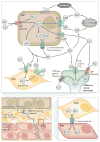Receptors, channels, and signalling in the urothelial sensory system in the bladder
- PMID: 26926246
- PMCID: PMC5257280
- DOI: 10.1038/nrurol.2016.13
Receptors, channels, and signalling in the urothelial sensory system in the bladder
Abstract
The storage and periodic elimination of urine, termed micturition, requires a complex neural control system to coordinate the activities of the urinary bladder, urethra, and urethral sphincters. At the level of the lumbosacral spinal cord, lower urinary tract reflex mechanisms are modulated by supraspinal controls with mechanosensory input from the urothelium, resulting in regulation of bladder contractile activity. The specific identity of the mechanical sensor is not yet known, but considerable interest exists in the contribution of transient receptor potential (TRP) channels to the mechanosensory functions of the urothelium. The sensory, transduction, and signalling properties of the urothelium can influence adjacent urinary bladder tissues including the suburothelial nerve plexus, interstitial cells of Cajal, and detrusor smooth muscle cells. Diverse stimuli, including those that activate TRP channels expressed by the urothelium, can influence urothelial release of chemical mediators (such as ATP). Changes to the urothelium are associated with a number of bladder pathologies that underlie urinary bladder dysfunction. Urothelial receptor and/or ion channel expression and the release of signalling molecules (such as ATP and nitric oxide) can be altered with bladder disease, neural injury, target organ inflammation, or psychogenic stress. Urothelial receptors and channels represent novel targets for potential therapies that are intended to modulate micturition function or bladder sensation.
Conflict of interest statement
statement M.A.V. is funded by the National Institutes of Health National Institute of Diabetes and Digestive and Kidney Diseases. The other authors declare no competing interests.
Figures



Comment in
-
Re: Receptors, Channels, and Signalling in the Urothelial Sensory System in the Bladder.J Urol. 2017 May;197(5):1315-1316. doi: 10.1016/j.juro.2017.02.061. Epub 2017 Feb 21. J Urol. 2017. PMID: 29539923 No abstract available.
References
-
- Tank PW. In: Grant’s dissector. Stacey SL, editor. Lippincott Williams & Wilkins; 2009.
-
- Andersson KE, McCloskey KD. Lamina propria: the functional center of the bladder? Neurourol Urodyn. 2013;33:9–16. - PubMed
-
- Davidson RA, McCloskey KD. Morphology and localization of interstitial cells in the guinea pig bladder: structural relationships with smooth muscle and neurons. J Urol. 2005;173:1385–1390. - PubMed
-
- Andersson KE, Arner A. Urinary bladder contraction and relaxation: physiology and pathophysiology. Physiol Rev. 2004;84:935–986. - PubMed
Publication types
MeSH terms
Substances
Grants and funding
LinkOut - more resources
Full Text Sources
Other Literature Sources

